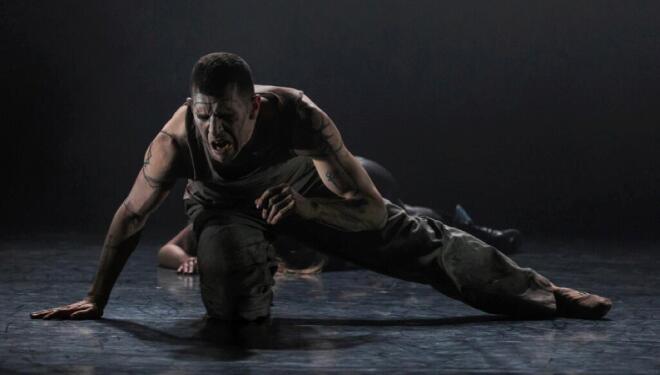
The 126-seat Ustinov studio offers a perfect setting for Brandstrup’s dance. Very intimate and affording thrilling proximity to the performers, it’s currently blazing a trail under the artistic direction of the formidable Deborah Warner, multi-award winning international director of dance, opera and theatre, whose credits in the UK, continental Europe and Broadway are far too numerous to list. Warner commissioned the two Brandstrup pieces; the first, MInotaur, premiered in 1922 as a companion piece for Benjamin Britten’s opera Phaedra; it is now paired with his new work Metamorphoses.
Drawing inspiration from classical mythology Brandstrup offers a startling fresh look at human frailty. Minotaur focuses in the guilt-ridden Ariadne, abandoned by the faithless Theseus after helping him kill her half-brother, the titular monster.
In Metamorphoses the choreographer subverts the story of Cupid and Psyche, focussing on Cupid as a feckless man-child.
The Royal Ballet principal Matthew Ball features in both, with Royal colleague Kristen McNally as Ariadne, and hip hop specialist Tommy Franzen as the title character in Minotaur; and former Royal and English National Ballet principal Alina Cojocaru as Psyche in Metamorphoses.
Set against Justin Nardella’s dark set of rugged stone walls, Brandstrup’s choreography is economical and intensely physical. The struggle between Theseus and the Minotaur is visceral, a pull-push of superhuman strength, muscles rippling, yet never straying beyond pure dance. It’s mesmerising. The duet between Theseus and Ariadne has a different intensity: she is passionately in love, yet guilt-ridden; he is distracted, plotting his escape. Left alone, Ariadne is haunted by the ghost of the Minotaur.

Tommy Franzen and Kristen Mcnally in Kim Brandstrup's Minotaur,. Photo: Foteini Christofilopoulou
In Metamorphoses, the myth tells how the love god Cupid kidnapped the beautiful Psyche but held her in darkness, so she could never look at him under pain of losing everything if she disobeys.
We first see Cojocaru’s Psyche, arms held in front of her, tentatively enter the stage, where a languid Cupid lies. He teases her, flees from her touch, before catching her and holding her aloft, as light as a feather, in games where playfulness borders on casual cruelty. When she disobeys and throws light on him, though, Cupid is forced to face her and himself and to accept love in a tender, deeply touching final pas de deux.
Brandstrup’s first love was cinema, and the techniques and visuals of cinema always permeate his work. Particularly in Metamorphoses, Chris Wilkinson’s lighting, with moving shafts of light to separate scenes, is often reminiscent of Carl Dreyer’s aesthetics.
Eilon Morris's sound design, collages of music ranging from haunting traditional choral pieces to Kurtág and Arvo Pãrt, is skilfully atmospheric but never intrusive.
We can only hope Metamorphoses comes to London; meanwhile, though, it more than justifies a visit to Bath.
| What | Kim Brandstrup's Metamorphoses Review |
| Where | Theatre Royal, Bath, Saw Ci, Bath, BA1 1ET | MAP |
| When |
29 Jan 24 – 10 Feb 24, 19:30 Dur.: 1 hour 25 mins approx inc one interval |
| Price | £41 (concessions available) |
| Website | https://www.theatreroyal.org.uk/whats-on/?ven=2740 |



